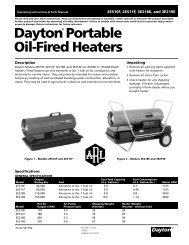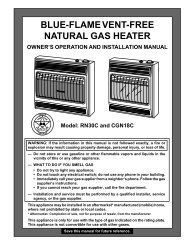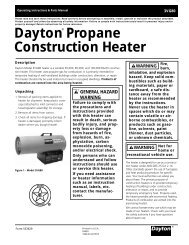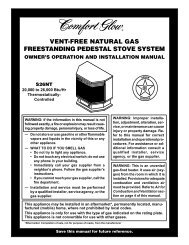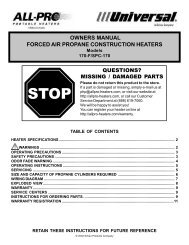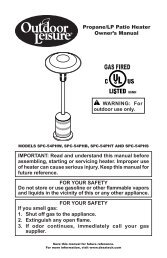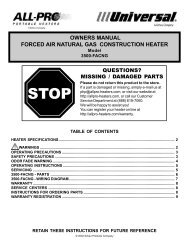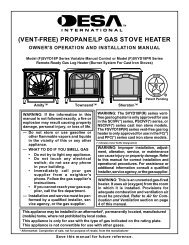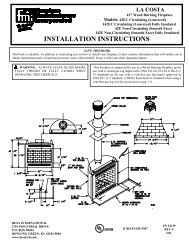AMITY (VENT-FREE) NATURAL GAS STOVE HEATER - Desa
AMITY (VENT-FREE) NATURAL GAS STOVE HEATER - Desa
AMITY (VENT-FREE) NATURAL GAS STOVE HEATER - Desa
Create successful ePaper yourself
Turn your PDF publications into a flip-book with our unique Google optimized e-Paper software.
104024AIR FORCOMBUSTIONAND<strong>VENT</strong>ILATIONWARNING ICON G 001WARNINGThis heater shall not be installed in a confined space unlessprovisions are provided for adequate combustion and ventilationair. Read the following instructions to insure proper freshair for this and other fuel-burning appliances in your home.Today’s homes are built more energy efficient than ever. New materials, increasedinsulation, and new construction methods help reduce heat loss in homes.Home owners weather strip and caulk around windows and doors to keep the coldair out and the warm air in. During heating months, home owners want theirhomes as airtight as possible.While it is good to make your home energy efficient, your home needs to breathe.Fresh air must enter your home. All fuel-burning appliances need fresh air forproper combustion and ventilation.Exhaust fans, fireplaces, clothes dryers, and fuel burning appliances draw airfrom the house to operate. You must provide adequate fresh air for these appliances.This will insure proper venting of vented fuel-burning appliances.PROVIDING ADEQUATE <strong>VENT</strong>ILATIONThe following is excerpts from National Fuel Gas Code. NFPA 54/ANSI Z223.1,Section 5.3, Air for Combustion and Ventilation.All spaces in homes fall into one of the three following ventilation classifications:1. Unusually Tight Construction; 2. Unconfined Space; 3. Confined Space.The information on pages 5 through 7 will help you classify your space and provideadequate ventilation.Unusually Tight ConstructionThe air that leaks around doors and windows may provide enough fresh air forcombustion and ventilation. However, in buildings of unusually tight construction,you must provide additional fresh air.Unusually tight construction is defined as construction where:a. walls and ceilings exposed to the outside atmosphere have a continuouswater vapor retarder with a rating of one perm (6x10 -11 perpa•sec•m 2 ) or less with openings gasketed or sealed andb. weather stripping has been added on openable windows and doorsandc. caulking or sealants are applied to areas such as joints around windowand door frames, between sole plates and floors, between wall-ceilingjoints, between wall panels, at penetrations for plumbing, electrical, andgas lines, and at other openings.If your home meets all of the three criteria above, you must provide additionalfresh air. See Ventilation Air From Outdoors, page 7.If your home does not meet all of the three criteria above, proceed to page 6.Confined and Unconfined SpaceThe National Fuel Gas Code (ANSIZ223.1, 1992 Section 5.3) defines a confined spaceas a space whose volume is less than 50 cubic feet per 1,000 Btu per hour (4.8 m 3 perkw) of the aggregate input rating of all appliances installed in that space and anunconfined space as a space whose volume is not less than 50 cubic feet per 1,000 Btuper hour (4.8 m 3 per kw) of the aggregate input rating of all appliances installed in thatspace. Rooms communicating directly with the space in which the appliances areinstalled*, through openings not furnished with doors, are considered a part of theunconfined space.* Adjoining rooms are communicating only if there are doorless passageways orventilation grills between them.Continued5
AIR FORCOMBUSTIONAND<strong>VENT</strong>ILATIONContinuedDETERMINING AIR FLOW FOR <strong>HEATER</strong> LOCATIONDetermining if You Have a Confined or Unconfined SpaceUse this work sheet to determine if you have a confined or unconfined space.Space: Includes the room in which you will install heater plus any adjoining rooms withdoorless passageways or ventilation grills between the rooms.1. Determine the volume of the space (length x width x height).Length x Width x Height = ___________________ cu. ft. (volume of space)Example: Space size 20 ft. (length) x 16 ft. (width) x 8 ft. (ceiling height) =2560 cu. ft. (volume of space)If additional ventilation to adjoining room is supplied with grills or openings, add thevolume of these rooms to the total volume of the space.2. Divide the space volume by 50 cubic feet to determine the maximum Btu/Hr the spacecan support.____________ (volume of space) ÷ 50 cu. ft. = (maximum Btu/Hr the space can support)Example: 2560 cu. ft. (volume of space) ÷ 50 cu. ft. = 51.2 or 51,200 (maximumBtu/Hr the space can support)3. Add the Btu/Hr of all fuel burning appliances in the space.Vent-free heater ___________________ Btu/HrGas water heater* ___________________ Btu/HrGas furnace___________________ Btu/HrVented gas heater ___________________ Btu/HrGas fireplace logs ___________________ Btu/HrOther gas appliances* + ___________________ Btu/HrTotal= ___________________ Btu/HrExample: Gas water heater 40,000 Btu/HrVent-free heater + 30,000 Btu/HrTotal = 70,000 Btu/Hr* Do not include direct-vent gas appliances. Direct-vent draws combustion air from theoutdoors and vents to the outdoors.4. Compare the maximum Btu/Hr the space can support with the actual amount of Btu/Hrused._________________ Btu/Hr (maximum the space can support)_________________ Btu/Hr (actual amount of Btu/Hr used)Example: 51,200 Btu/Hr (maximum the space can support)70,000 Btu/Hr (actual amount of Btu/Hr used)The space in the above example is a confined space because the actual Btu/Hr used is morethan the maximum Btu/Hr the space can support. You must provide additional fresh air.Your options are as follows:A. Rework worksheet, adding the space of an adjoining room. If the extra space providesan unconfined space, remove door to adjoining room or add ventilation grills betweenrooms. See Ventilation Air From Inside Building, page 7.B. Vent room directly to the outdoors. See Ventilation Air From Outdoors, page 7.C. Install a lower Btu/Hr heater, if lower Btu/Hr size makes room unconfined.If the actual Btu/Hr used is less than the maximum Btu/Hr the space can support, thespace is an unconfined space. You will need no additional fresh air ventilation.6104024
AIR FORCOMBUSTIONAND<strong>VENT</strong>ILATIONContinuedWARNING ICON G 001WARNINGIf the area in which the heater may be operated is smaller thanthat defined as an unconfined space, provide adequate combustionand ventilation air by one of the methods described in theNational Fuel Gas Code, ANSI Z223.1, 1992, Section 5.3 or applicablelocal codes.<strong>VENT</strong>ILATION AIRVentilation Air From Inside BuildingThis fresh air would come from an adjoining unconfined space. When ventilating to anadjoining unconfined space, you must provide two permanent openings: one within 12" of theceiling and one within 12" of the floor on the wall connecting the two spaces (see options 1and 2, Figure 2). You can also remove door into adjoining room (see option 3, Figure 2).Follow the National Fuel Gas Code NFPA 54/ANSI Z223.1, Section 5.3, Air for Combustionand Ventilation for required size of ventilation grills or ducts.WARNING ICON G 001WARNINGRework worksheet, adding the space of the adjoining unconfinedspace. The combined spaces must have enough fresh air to supply allappliances in both spaces.12"VentilationGrillsInto AdjoiningRoom,Option 1OrRemoveDoor intoAdjoiningRoom,Option3Ventilation GrillsInto Adjoining Room,Option 212"Figure 2 - Ventilation Air from Inside BuildingVentilation Air From OutdoorsProvide extra fresh air by using ventilation grills or ducts. You must provide two permanentopenings: one within 12" of the ceiling and one within 12" of the floor. Connect theseitems directly to the outdoors or spaces open to the outdoors. These spaces include atticsand crawl spaces.IMPORTANT: Do not provide openings for inlet or outlet air into attic if attic has athermostat-controlled power vent. Heated air entering the attic will activate the powervent.OutletAirVentilatedAtticOutletAirTo Attic104024InletAirInlet AirVentilatedCrawl SpaceToCrawlSpaceFigure 3 - Ventilation Air from Outdoors7
INSTALLINGNOTICEA qualified service person must install heater. Follow all local codes.NOTICEState or local codes may only allow operation of this appliance in avented configuration. Check your state or local codes.WARNING ICON G 001WARNINGNever install the heater• in a bedroom or bathroom• in a recreational vehicle• where curtains, furniture, clothing, or other flammable objects areless than 36 inches from the front, top, or sides of the heater• in high traffic areas• in windy or drafty areasWARNING ICON G 001CAUTIONThis heater creates warm air currents. These currents move heatto wall surfaces next to heater. Installing heater next to vinyl orcloth wall coverings or operating heater where impurities in the air(such as tobacco smoke) exist, may discolor walls.IMPORTANT: Vent-free heaters add moisture to the air. Although this is beneficial,installing heater in rooms without enough ventilation air may cause mildewto form from too much moisture. See Air for Combustion and Ventilation, pages 5through 7.CHECK <strong>GAS</strong> TYPEUse only natural gas. If your gas supply is not natural gas, do not install heater.Call dealer where you bought heater for proper type heater.CLEARANCES TO COMBUSTIBLES (Vent-Free Operation Only)WARNING ICON G 001WARNINGMaintain the minimum clearances. If you can, provide greater clearancesfrom floor, ceiling, and adjoining side and back walls.Carefully follow the instructions below. This stove is a freestanding unit designedto set directly on the floor. IMPORTANT: You must maintain minimum wall andceiling clearances during installation. The minimum clearances are shown inFigure 4, page 9. Measure from outermost point of stove top.Minimum Wall and Ceiling Clearances (see Figure 4)A. Clearances from outermost point of stove top to any combustible side wallshould not be less than 12 inches.B. Clearances from outermost point of stove top to any combustible back wallshould not be less than 6 inches (Includes Corner Installations).C. Clearances from the stove top to the ceiling should not be less than 48 inches.8104024
INSTALLINGContinuedFront ViewCeiling48"MinimumSide Wall12"Minimum12"MinimumSide WallTop ViewBack Wall6 "MinimumSide View12 "Minimum12 "MinimumCeilingSide WallSide Wall48"MinimumCornerWall6 "MinimumFront ofStove Unit6"MinimumBack WallWall6 "MinimumFloorFigure 4 - Minimum Clearance to Walls and Ceiling<strong>STOVE</strong> CAVITY ASSEMBLY1. Lift off corrugated box enclosing stove body crating.2. Remove all screws fastening the wood frame enclosure. Spread wood frameopen and lift away from plastic-bagged stove body. The bottom pieces ofpallet wood will remain bolted to the stove body.3. Remove plastic bag from stove body.4. Remove back panel from stove (see Figure 5). Use an adjustable wrench or a10 mm socket. Remove six (6) bolts and washers. Keep bolts and washers toreattach back panel later.BoltProductIdentificationLabelBack Stove Panel104024Figure 5 - Removing Back PanelContinued9
INSTALLINGContinued5. Remove all contents from inside stove cavity. Contents include:(1) - Stove bottom(4) - Legs with leg leveler bolts(1) - Bottom door(1) - Top grate(1) - Hardware kit bag with fasteners6. Carefully lay stove body on back to attach bottom components to stove body(see Figure 6). Rest stove on drop cloth or blanket to avoid scratching stoveedges.Top ofStove UnitFront ofStove UnitFront ofStove UnitTop ofStove UnitDrop Cloth/BlanketPallet WoodBolted toStove BodyBottomFigure 6 - Laying Down Stove On Side7. Remove remaining pallet wood attached to bottom of stove body (see Figure 7).Use an adjustable wrench to remove bolts.FrontBoltPalletWoodPalletWoodBottom OfStove UnitFigure 7 - Removing Pallet Wood From The Bottom of The StoveDoor Hinge StepBolt HoleLegHoleFrontDoor Catch BoltWith AdjustableHex Nuts HoleLegHoleLegHoleStoveBottom HoleLegHoleBottom OfStove Unit10Figure 8 - Locating of Threaded Holes for StoveBottom, Legs, and Door Attachment104024
INSTALLINGContinued8. Fasten each leg to stove with four (4) M8 x 1.25 - 20mm bolts. Use a flatwasher and lock washer with each bolt. Tighten bolts into threaded holes onstove body (see Figure 8 and 9). Use an adjustable wrench or a 12mm socket.BoltWashersBottom OfStove UnitLegFigure 9 - Attaching Stove Legs9. Fasten stove bottom to stove with four (4) M6 x 1 - 25mm bolts. Use a flatwasher and lock washer with each bolt. Tighten bolts into threaded holes onstove body (see Figure 8 and 10). Use an adjustable wrench or a 10mm socket.WashersBoltStoveBottomBottom OfStove UnitFigure 10 - Attaching Stove Bottom104024Continued11
INSTALLINGContinued10. Attach stove door by inserting step bolt through door hinge pivot hole and intothreaded hole in stove body (see Figure 8 and 11). Use an adjustable wrench or a12mm socket to fasten step bolt. Tighten step bolt until snug. Make sure doormoves freely.StoveDoorStoveDoorThreadedHoleBoltShoulderDoorHingeDoorHingeStepBoltStepBoltBoltShoulderStove BottomFigure 11 - Attaching Stove Door11. Install door catch bolt (M8 x 1.25-55mm with two M8 hex nuts) into threadedhole on stove body (see Figure 8, page 10). Use an adjustable wrench or a12mm socket. The catch bolt has two hex nuts attached to it (see Figure 12).The top nut is a bolt stop and the bottom nut is for door leveling adjustment.Bolt StopAdjusting NutDoorDoor ClawCatch BoltFigure 12 - Catch Bolt and Door Claw Orientation1212. Check general catch bolt alignment with door claw. Make final adjustment anddoor leveling after stove is in normal standing position.13. Carefully lift stove back up on its four attached legs.14. Set top grate into stove top.15. If available, install gas log heater inside stove cavity before installing the backpanel (see Installing Gas Log Heater Into Stove page 13).16. Fasten back panel to stove with six (6) M6 x 1 - 20mm bolts and washers. Makesure product identification label is located on the outside in lower left-handcorner.104024
INSTALLINGContinuedINSTALLING <strong>GAS</strong> LOG <strong>HEATER</strong> INTO <strong>STOVE</strong>1. Remove log and gas log heater from carton. Note: Do not pick up gas logheater by the burner itself. This could damage heater. Always handle the gaslog heater by the heater base only.2. Remove all protective packaging applied to log and gas log heater for shipment.3. Check all items for any shipping damage. If damaged, promptly inform dealerwhere you bought heater.4. If not already removed, remove back panel from assembled stove body (seeFigure 5, page 9). Use an adjustable wrench or a 10 mm socket. Remove six(6) bolts and washers. Keep bolts and washers to reattach back panel later.5. Set gas log heater inside stove. Make sure control knob extension passesthrough bottom front opening (see Figure 13).BurnerBottomFrontOpeningBoltHeaterBaseStoveBottomFigure 13 - Placing Heater Base In Stove Cavity6. Align outside holes on heater base with four (4) mounting holes on the stovebottom (see Figure 13).7. Fasten heater base to stove bottom with #10-24 x .50 bolts and hex nutsprovided with gas log heater (see Figure 14). Attachment hardware is factorypacked inside plastic bag with installation manual and owner’s registrationcard. Push bolt through heater base mounting hole and through stove bottom.Connect hex nut to bolt on underside of stove bottom. The bolt hex head is fora 5/16" socket and the hex nuts are for a 3/8" socket. If sockets are not available,use adjustable wrenches.BoltHeaterBaseHex NutStoveBottom104024Figure 14 - Fastening Heater Base to Stove Drop BottomContinued13
INSTALLINGContinued8. Set one-piece log on heater base as shown in Figure 15. Make sure middlesection at bottom of log is seated into "U" shaped cutout in center of heaterbase. Log will fit securely on base. IMPORTANT: Make sure log does notcover any burner ports and does not touch the stove cavity (see Figure 16).One-PieceLog SetMiddle Section atBottom of Log SetBurner"U" ShapedCutout in ChassisHeater BaseFigure 15 - Installing One-Piece Stove Log SetSafety PilotLocationBurner Porting Areas(double slottedrectangular openingsOne-PieceLog SetFigure 16 - Top View of One-Piece Log Set on Gas Log Heater9. Fasten back panel to stove with six (6) M6 x 1.20mm bolts and washers. Makesure product identification label is located on the outside lower left-handcorner.10. Place freestanding stove in desired position in room. Be sure to maintainclearances to combustibles as outlined on page 8.CONNECTING TO <strong>GAS</strong> SUPPLYNOTICEA qualified service person must connect heater to gas supply.Follow all local codes.14Installation Items NeededBefore installing heater, make sure you have the items listed below.• piping (check local codes)• sealant (resistant to LP gas)• manual shutoff valve *• test gauge connection *• sediment trap• tee joint• pipe wrench104024
INSTALLINGContinued* An A.G.A. design-certified manual shutoff valve with 1/8" NPT tap is an acceptablealternative to test gauge connection. Purchase the optional A.G.A. design-certified manualshutoff valve from your dealer. See Accessory, page 30.The gas regulator for the stove heater is located on the lower right-hand side of thestove when viewed from the front of the unit. The gas connection can be made eitherthrough the bottom right side or through the lower back opening as illustrated inFigure 17. Make sure gas log heater is secured to the stove cavity assembly.Side ViewBack ViewFront ofStove UnitGasRegulatorAccessProductIdentificationLabelBack StovePanelGas LogHeaterFigure 17 - Gas Regulator Location and Gas Line Access Into Stove CabinetWARNING ICON G 001WARNINGNever connect heater to private (non-utility) gas wells. This gas iscommonly known as wellhead gas.WARNING ICON G 001CAUTIONUse only new, black iron or steel pipe. Internally-tinned coppertubing may be used in certain areas. Check your local codes. Usepipe of 1/2" diameter or greater to allow proper gas volume toheater. If pipe is too small, undue loss of pressure will occur.Installation must include a manual shutoff valve, union, and plugged 1/8" NPTtap. Locate NPT tap within reach for test gauge hook up. NPT tap must be upstreamfrom heater (see Figure 18, page 16).Apply pipe joint sealant lightly to male threads. This will prevent excess sealantfrom going into pipe. Excess sealant in pipe could result in clogged heater valves.WARNING ICON G 001CAUTIONUse pipe joint sealant that is resistant to liquid petroleum (LP) gas.Install sediment trap in supply line as shown in Figure 18, page 16. Locate sedimenttrap where it is within reach for cleaning. Locate sediment trap wheretrapped matter is not likely to freeze. A sediment trap traps moisture and contaminants.This keeps them from going into heater controls. If sediment trap is notinstalled or is installed wrong, heater may not run properly.104024Continued15
INSTALLINGContinuedWARNING ICON G 001CAUTIONAvoid damage to regulator. Hold gas regulator with wrench whenconnecting it to gas piping and/or fittings.FromGas Meter(5" W.C.** to10.5" W.C.Pressure)A.G.A. Design-CertifiedManual Shutoff ValveWith 1/8" NPT Tap*Approved FlexibleGas Hose (if allowedby local codes)GasRegulatorTee JointPipeNippleCap3" MinimumSedimentTrapFigure 18 - Gas Connection* Purchase the optional A.G.A. design-certified manual shutoff valve from yourdealer. See Accessory, page 30.** Minimum inlet pressure for purpose of input adjustment.CHECKING <strong>GAS</strong> CONNECTIONSWARNING ICON G 001WARNINGTest all gas piping and connections for leaks after installing orservicing. Correct all leaks at once.WARNING ICON G 001WARNINGNever use an open flame to check for a leak. Apply a mixture ofliquid soap and water to all joints. Bubbles forming show a leak.Correct all leaks at once.16Pressure Testing Gas Supply Piping SystemTest Pressures In Excess Of 1/2 PSIG1. Disconnect heater and its individual manual shutoff valve from gas supplypiping system. Pressures in excess of 1/2 psig will damage heater regulator.2. Cap off open end of gas pipe where manual shutoff valve was connected.3. Pressurize supply piping system by either using compressed air or openingmain gas valve located on or near gas meter.4. Check all joints of gas supply piping system. Apply mixture of liquid soap andwater to gas joints. Bubbles forming show a leak.5. Correct all leaks at once.6. Reconnect heater and manual shutoff valve to gas supply. Check reconnectedfittings for leaks.104024
INSTALLINGContinuedTest Pressures Equal To or Less Than 1/2 PSIG1. Close manual shutoff valve (see Figure 19).2. Pressurize supply piping system by either using compressed air or openingmain gas valve located on or near gas meter.3. Check all joints from gas meter to manual shutoff valve (see Figure 20). Applymixture of liquid soap and water to gas joints. Bubbles forming show a leak.4. Correct all leaks at once.Pressure Testing Heater Gas Connections1. Open manual shutoff valve (see Figure 19).2. Open main gas valve located on or near gas meter.3. Make sure control knob of heater is in the OFF position.4. Check all joints from manual shutoff valve to control valve (see Figure 20). Applymixture of liquid soap and water to gas joints. Bubbles forming show a leak.5. Correct all leaks at once.6. Light heater (see Operating Heater, pages 18 through 20). Check all otherinternal joints for leaks.7. Turn off heater (see To Turn Off Gas to Appliance, page 20).OpenONPOSITIONManualShutoffValveOFFPOSITIONClosedFigure 19 - Manual Shutoff ValveManualShutoffValveControl Valve LocationGas MeterFigure 20 - Checking Gas Joints10402417
OPERATING<strong>HEATER</strong>FOR YOUR SAFETY READ BEFORE LIGHTINGWARNING ICON G 001WARNINGIf you do not follow these instructions exactly, a fire or explosion mayresult causing property damage, personal injury or loss of life.A. This appliance has a pilot which must be lighted by hand. When lighting the pilot,follow these instructions exactly.B. BEFORE LIGHTING smell all around the appliance area for gas. Be sure to smellnext to the floor because some gas is heavier than air and will settle on the floor.WHAT TO DO IF YOU SMELL <strong>GAS</strong>• Do not try to light any appliance.• Do not touch any electric switch; do not use any phone in your building.• Immediately call your gas supplier from a neighbor’s phone. Follow the gassupplier’s instructions.• If you cannot reach your gas supplier, call the fire department.C. Use only your hand to push in or turn the gas control knob. Never use tools. If theknob will not push in or turn by hand, don’t try to repair it, call a qualified servicetechnician or gas supplier. Force or attempted repair may result in a fire orexplosion.D. Do not use this appliance if any part has been under water. Immediately call aqualified service technician to inspect the appliance and to replace any part of thecontrol system and any gas control which has been under water.LIGHTING INSTRUCTIONSNOTICEDuring initial operation of new heater, burning logs will give off a paperburningsmell. Open damper or window to vent smell. This will only last afew hours.1. STOP! Read the safety information above.2. Make sure manual shutoff valve is fully open.3. Press in and turn control knob clockwise to the OFF position.Ignitor ButtonControl KnobFigure 21 - Control Knob and Ignitor Button Location18104024
OPERATING<strong>HEATER</strong>Continued4. Wait five (5) minutes to clear out any gas. Then smell for gas, including near thefloor. If you smell gas, STOP! Follow “B” in the safety information on page 18 . Ifyou don’t smell gas, go to the next step.5. Slightly depress and turn control knob counterclockwise C-clockwise to the PILOTposition. Keep control knob pressed in for five (5) seconds (see Figure 21, page 18).Note: You may be running this heater for the first time after hooking up to gassupply. If so, the control knob may need to be pressed in for 30 seconds. Thiswill allow air to bleed from the gas system.6. With control knob pressed in, press and release ignitor button. This will lightpilot. The pilot is attached to the burner (see Figure 16, page 14). If needed, keeppressing ignitor button until pilot lights.Note: If pilot does not light, contact a qualified service person or gas supplierfor repairs. Until repairs are made, light pilot with match. To light pilot withmatch, see Manual Lighting Procedure on page 20.7. Keep control knob pressed in for 30 seconds after lighting pilot. After 30 seconds,release control knob.Note: If pilot goes out, repeat steps 3 through 7.• If control knob does not pop out when released, contact a qualified serviceperson or gas supplier for repairs.ThermocoupleIgnitor ElectrodePilot BurnerFigure 22 - Pilot8. Slightly depress and turn control knob counterclockwiseC-clockwiseto the HIGHposition. The burner should light. Set control knob to any heat level betweenHIGH and LO.VARIABLE CONTROL OPERATIONThe variable control valve can be set to any heat setting and flame height desired, bysimply turning the control knob until that setting is attained. Even the lowest settingprovides realistic, dancing yellow flames. Selecting higher settings produces greaterheat output. This results in increased heating comfort.WARNING ICON G 001WARNINGDo not operate heater between PILOT and HIGH positions.WARNING ICON G 001CAUTIONDo not try to adjust heating levels by using the manual shutoff valve.104024Continued19
OPERATING<strong>HEATER</strong>ContinuedTO TURN OFF <strong>GAS</strong> TO APPLIANCEShutting Off Heater1. Press in and turn control knob clockwise Clockwise to the HIGH position.2. Turn the control knob clockwise Clockwise to the PILOT position.3. Press in control knob and turn clockwise Clockwise to the OFF Position.Shutting Off Burners Only (pilot stays lit)1. Turn the control knob clockwise Clockwise to the HIGH position.2. Press in and turn control knob clockwise Clockwise to the PILOT position.MANUAL LIGHTING PROCEDURE1. Follow steps 1 through 5 under Lighting Instructions, pages 18 and 19.2. Pilot is located inside stove cavity attached to burner. Lift off top grate to allowaccess to pilot.3. Depress control knob and light pilot with match.4. Keep control knob pressed in for 30 seconds after lighting pilot. After 30seconds, release control knob.5. Place top grate back into position. Now follow step 8, page 19.INSPECTINGBURNERSCheck pilot flame pattern and burner flame patterns often.PILOT FLAME PATTERNFigure 23 shows a correct pilot flame pattern. Figure 24 shows an incorrect pilot flamepattern. The incorrect pilot flame is not touching the thermocouple. This will cause thethermocouple to cool. When the thermocouple cools, the heater will shut down.Thermocouple Pilot Burner Pilot BurnerThermocoupleFigure 23 - Correct PilotFlame PatternFigure 24 - Incorrect PilotFlame PatternIf pilot flame pattern is incorrect, as shown in Figure 24• turn heater off (see To Turn Off Gas to Appliance, above)• see Troubleshooting, pages 21 through 2420104024
CLEANINGANDMAINTENANCEWARNING ICON G 001WARNINGTurn off heater and let cool before cleaning.WARNING ICON G 001CAUTIONYou must keep control areas, burner, and circulating air passagewaysof heater clean. Inspect these areas of heater before eachuse. Have heater inspected yearly by a qualified service person.Heater may need more frequent cleaning due to excessive lint fromcarpeting, bedding material, etc.ODS/PILOT AND BURNER• Use a vacuum cleaner or small, soft bristled brush to clean.LOGS• Replace log(s) if broken or chipped (dime-sized or larger).TROUBLE-SHOOTINGNote: All troubleshootingitems are listed in order ofoperation.WARNING ICON G 001WARNINGTurn off heater and let cool before servicing. Only a qualifiedservice person should service and repair heater.WARNING ICON G 001CAUTIONNever use a wire, needle, or similar object to clean ODS/pilot. Thiscan damage ODS/pilot unit.OBSERVEDPROBLEMWhen ignitor buttonis pressed, there is nospark at ODS/pilotPOSSIBLECAUSE1. Ignitor electrode not connectedto ignitor cable2. Ignitor cable pinched orwet3. Piezo ignitor nut is loose4. Broken ignitor cable5. Bad piezo ignitor6. Ignitor electrode positionedwrong7. Ignitor electrode brokenREMEDY1. Reconnect ignitor cable2. Free ignitor cable ifpinched by any metal ortubing. Keep ignitorcable dry3. Tighten nut holdingpiezo ignitor to basepanel of log set. Nut islocated behind basepanel.4. Replace ignitor cable5. Replace piezo ignitor6. Replace ignitor7. Replace ignitor104024Continued21
TROUBLE-SHOOTINGContinuedOBSERVEDPROBLEMWhen ignitor buttonis pressed, there isspark at ODS/pilotbut no ignitionPOSSIBLECAUSE1. Gas supply turned off ormanual shutoff valveclosed2. Control knob not inPILOT position3. Control knob notpressed in while inPILOT position4. Air in gas lines wheninstalled5. ODS/pilot is clogged6. Gas regulator setting isnot correctREMEDY1. Turn on gas supply oropen manual shutoffvalve2. Turn control knob toPILOT position3. Press in control knobwhile in PILOT position4. Continue holding downcontrol knob. Repeatigniting operation untilair is removed5. Clean ODS/pilot (seeCleaning and Maintenance,page 21) orreplace ODS/pilotassembly6. Replace gas regulatorODS/pilot lights butflame goes out whencontrol knob isreleased1. Control knob not fullypressed in2. Control knob notpressed in long enough3. Safety interlock systemhas been triggered4. Manual shutoff valvenot fully open5. Pilot flame not touchingthermocouple, whichallows thermocouple tocool, causing pilot flameto go out. This problemcould be caused by oneor both of the following:A) Low gas pressureB) Dirty or partiallyclogged ODS/pilot6. Thermocouple connectionloose at controlvalve7. Thermocouple damaged8. Control valve damaged1. Press in control knobfully2. After ODS/pilot lights,keep control knobpressed in 30 seconds3. Wait one minute forsafety interlock systemto reset. Repeat ignitionoperation4. Fully open manualshut-off valve5. A) Contact localnatural gas companyB) Clean ODS/pilot(see Cleaning andMaintenance, page 21)or replace ODS/pilotassembly6. Hand tighten untilsnug, then tighten 1/4turn more7. Replace thermocouple8. Replace control valve22104024
TROUBLE-SHOOTINGContinuedOBSERVEDPROBLEMBurner does not lightafter ODS/pilot is litPOSSIBLECAUSE1. Inlet gas pressure istoo low2. Burner orifice clogged3. Burner orifice diameteris too smallREMEDY1. Contact local naturalgas company2. Clean burner (seeCleaning and Maintenance,page 21) orreplace burner orifice3. Replace burner orificeDelayed ignitionburner1. Manifold pressure istoo low2. Burner orifice clogged1. Contact local naturalgas company2. Clean burner (seeCleaning and Maintenance,page 21) orreplace burner orificeBurner backfiringduring combustion1. Burner orifice isclogged or damaged2. Damaged burner3. Gas regulator defective1. Clean burner (seeCleaning and Maintenance,page 21) orreplace burner orifice2. Replace damagedburner3. Replace gas regulatorSlight smoke or odorduring initial operation1. Not enough air2. Gas regulator defective3. Residues from manufacturingprocessesand logs curing1. Check burner for dirtand debris. If found,clean burner (seeCleaning and Maintenance,page 21)2. Replace gas regulator3. Problem will stop aftera few hours of operationHeater produces awhistling noise whenburner is lit1. Turning control knobto HI position whenburner is cold2. Air in gas line3. Air passageways onheater blocked4. Dirty or partiallyclogged burner orifice1. Turn control knob toLO position and letwarm up for a minute2. Operate burner until airis removed from line.Have gas line checkedby local natural gascompany3. Observe minimuminstallation clearances(see pages 8-9)4. Clean burners (seeCleaning and Maintenance,page 21) orreplace burner orificeMoisture/condensationnoticed on windows1. Not enough combustion/ventilationair1. Refer to Air for Combustionand Ventilationrequirements (pages 5-7)104024Continued23
TROUBLE-SHOOTINGContinuedWARNING ICON G 001WARNINGIf you smell gas• Shut off gas supply.• Do not try to light any appliance.• Do not touch any electrical switch; do notuse any phone in your building.• Immediately call your gas supplier froma neighbor’s phone. Follow the gassupplier’s instructions.• If you cannot reach your gas supplier, callthe fire department.IMPORTANT: Operating heater where impurities in air exist may create odors.Cleaning supplies, paint, paint remover, cigarette smoke, cements and glues, newcarpet or textiles, etc., create fumes. These fumes may mix with combustion airand create odors. These odors will disappear over time.OBSERVEDPROBLEMHeater produces aclicking/ticking noisejust after burner is lit orshut offHeater producesunwanted odorsHeater shuts off in use(ODS operates)Gas odor even whencontrol knob is in OFFpositionGas odor duringcombustionPOSSIBLECAUSE1. Metal expanding whileheating or contractingwhile cooling1. Heater burning vaporsfrom paint, hair spray,glues, cleaners, chemicals,new carpet, etc. (SeeIMPORTANT statementabove)2. Gas leak. See Warningstatement at top ofpage1. Not enough fresh air isavailable2. Low line pressure3. ODS/pilot is partiallyclogged1. Gas leak. See Warningstatement at top ofpage2. Control valve defective1. Foreign matter betweencontrol valve and burner2. Gas leak. See Warningstatement at top ofpageREMEDY1. This is common withmost heaters. If noise isexcessive, contactqualified service person1. Open window andventilate room. Stopusing odor causingproducts while heater isrunning2. Locate and correct allleaks (see Checking GasConnections, page 16)1. Open window and/ordoor for ventilation2. Contact local naturalgas company3. Clean ODS/pilot (seeCleaning and Maintenance,page 21)1. Locate and correct allleaks (see Checking GasConnections, page 16)2. Replace control valve1. Take apart gas tubing andremove foreign matter2. Locate and correct allleaks (see Checking GasConnections, page 16)24104024
104024TECHNICALSERVICESPECIFICATIONSSERVICEHINTSREPLACEMENTPARTSYou may have further questions about installation, operation, or troubleshooting.If so, contact DESA International’s Technical Service Department at1-800-DESA LOG (1-800-337-2564).Amity Stove Gas Log HeaterModel SVYD18NVariable Manually ControlledBtu (Variable) 16,000/30,000Type GasNatural Gas OnlyIgnitionPiezoPressure Manifold3.5" W.C.Inlet Gas Pressure (in. of water)Maximum 10.5"Minimum* 5"* For input adjustmentShipping Weight28 lbs.Amity Stove CabinetModel SCIVF(*)Shipping Weight195 lbs.(* Indicates Color Suffix Designation)When gas pressure is too low• pilot will not stay lit• burners will have delayed ignition• heater will not produce specified heatWhen gas quality is bad• pilot will not stay lit• burners will produce flames and soot• heater will backfire when litYou may feel your gas pressure is too low or gas quality is bad. If so, contact yourlocal natural gas supplier.Note: Use only original replacement parts. This will protect your warranty coveragefor parts replaced under warranty.Parts Under WarrantyContact authorized dealers of this product. If they can’t supply original replacementpart(s), call DESA International’s Technical Service Department at1-800-323-5190. When calling DESA International, have ready• your name and address• model number of your heater• how heater was malfunctioning• type of gas used (propane or natural gas)• purchase dateUsually, we will ask you to return the defective part to the factory.Parts Not Under WarrantyContact authorized dealers of this product. If they can’t supply original replacementpart(s), call DESA International’s Parts Department at 1-800-972-7879 forreferral information. When calling DESA International, have ready• model number of your heater• the replacement part number25
ILLUSTRATEDPARTSBREAKDOWNSVYD18N111171919-219-1310189612572020841321720212022141618152026104024
PARTS LISTSVYD18NThis list contains replaceable parts used in your heater. When ordering parts,follow the instructions listed under Replacement Parts on page 25 of this manual.KEY PARTNO. NO. DESCRIPTION QTY.1 104026-01 Stove Log 12 098276-01 Hex Head Plug, 1/8" NPT 13 098249-01 Nut, M5 24 102776-05CK Painted Base Assembly 15 102844-02 Lower Bracket 16 102966-02 Upper Bracket 17 098867-11 Gas Regulator 18 102798-01 Inlet Tube 19 102779-03 Outlet Burner Tube 110 099056-26 Burner Orifice Injector 111 102843-01 Burner Clip 112 102980-01 Burner 113 102568-07 Control Valve 114 098508-01 Valve Retainer Nut 115 099393-03 Control Knob 116 102445-01 Piezo Ignitor 117 099387-08 Pilot Tube 118 098271-07 Ignitor Cable 119 103042-01 ODS Pilot 119-1 098594-01 Ignitor Electrode 119-2 098593-01 Thermocouple 120 M11084-38 Screw, Hex Head (#8-18 x .38) 1521 098325-01 Roll Pin 122 098462-04 Control Rod Assembly 123 104055-01CK Extension Base 1PARTS AVAILABLE — NOT SHOWN100563-01 Warning Plate 1101055-02 Lighting Instructions Plate 1100565-01 Warning Plate Fastener 1101449-06 Control Position Decal 1M12461-71 Screw, Hex Head #10-24 x .50 - Mounting 4NPC-3C Hex Nut, #10-24 - Mounting 4101416-36 Information Video 110402427
ILLUSTRATEDPARTSBREAKDOWNSCIVFC, SCIVFB,SCIVFG, SCIVFR12115557-4657-147-27-328104024
PARTS LISTSCIVFC, SCIVFB,SCIVFG, SCIVFRThis list contains replaceable parts used in your heater. When ordering parts,follow the instructions listed under Replacement Parts on page 25 of this manual.KEY PARTNO. NO. DESCRIPTION QTY.1 104171-01 Top Grate with Screen (Black Only) 12 104172-01 Stove Back Panel (Black Only) 13 104173-01 Bottom Door (Charcoal) 1104173-02 Bottom Door (Azure Blue) 1104173-03 Bottom Door (Hunter Green) 1104173-04 Bottom Door (Burgundy Red) 14 104174-01 Stove Dropped Bottom 15 104175-01 One Leg (Charcoal) (4 Total Per Stove) 1104175-02 One Leg (Azure Blue) (4 Total Per Stove) 1104175-03 One Leg (Hunter Green) (4 Total Per Stove) 1104175-04 One Leg (Burgundy Red) (4 Total Per Stove) 16 104176-01 Leg Leveler Bolt M8 x 1.25 - 55mm Long(4 Total Per Stove) 17 104177-01 Hardware Kit 17-1 * Door Hinge Step Bolt With Shoulder (1 Per Unit) 17-2 * Door Catch Bolt M8 x 1.25 - 55mm LongWith Two M8 Hex Nuts (1 Per Unit) 17-3 * Bottom Floor Bolts M6 x 1 - 25mm Long WithFlat Washer And Lock Washer (4 Per Unit) 17-4 * Leg Bolts M6 x 1.25 - 20mm Long With FlatWasher And Lock Washer (4 Per Unit) 111 104178-01 Back Panel Bolts M6 x 1 - 20mm Long With FlatWasher And Lock Washer (6 Per Unit) 1PARTS AVAILABLE — NOT SHOWN104108-01 Touch-up Spray Paint 12 oz Can (Charcoal) 1104108-02 Touch-up Spray Paint 12 oz Can (Azure Blue) 1104108-03 Touch-up Spray Paint 12 oz Can (Hunter Green) 1104108-04 Touch-up Spray Paint 12 oz Can (Burgundy Red) 1* Included In Hardware Kit10402429
ACCESSORYPurchase these heater accessories from your local dealer. If they can not supplythese accessories, call DESA International’s Parts Department at 1-800-972-7879for referral information. You can also write to the address listed on the back page ofthis manual.MANUAL SHUTOFFVALVE - GA5010For all models. Manual shutoff valve with 1/8" NPTtap. Fits 1/2" NPT pipe.30104024
NOTES______________________________________________________________________________________________________________________________________________________________________________________________________________________________________________________________________________________________________________________________________________________________________________________________________________________________________________________________________________________________________________________________________________________________________________________________________________________________________________________________________________________________________________________________________________________________________________________________________________________________________________________________________________________________________________________________________________________________________________________________________________________________________________________________________________________________________________________________________________________________________________________________________________________________________________________________________________________________________________________________________________________________________________________________________________________________________________________________________________________________________________________________________________________________________________________________________________________________________________________________________________________________________________________________________________________________________________________________________________________________________________________________________________________________________________________________________________________________________________________________________________________________________________________________________________________________________________________________________________________________________________________________________________________________________________________________________________________________________________________________________________________________________________________________________________________________________________________________________________________________________________________________________________________________________10402431
WARRANTY INFORMATIONKEEP THIS WARRANTYModelSerial No.Date PurchasedAlways specify model and serial numbers when communicating with the factory.We reserve the right to amend these specifications at any time without notice. The only warranty applicable is ourstandard written warranty. We make no other warranty, expressed or implied.LIMITED WARRANTY<strong>VENT</strong>-<strong>FREE</strong> <strong>NATURAL</strong> <strong>GAS</strong> LOG <strong>HEATER</strong>S AND <strong>AMITY</strong> <strong>STOVE</strong> CHASSISDESA International warrants this product to be free from defects in materials and components for three (3) years from thedate of first purchase, provided that the product has been properly installed, operated and maintained in accordance withall applicable instructions. To make a claim under this warranty the Bill of Sale or cancelled check must be presented.This warranty is extended only to the original retail purchaser. This warranty covers the cost of part(s) required to restorethis heater to proper operating condition and an allowance for labor when provided by a DESA Authorized Service Center.Warranty part(s) MUST be obtained through authorized dealers of this product and/or DESA International who willprovide original factory replacement parts. Failure to use original factory replacement parts voids this warranty. The heaterMUST be installed by a qualified installer in accordance with all local codes and instructions furnished with the unit.This warranty does not apply to parts that are not in original condition because of normal wear and tear, or parts that failor become damaged as a result of misuse, accidents, lack of proper maintenance or defects caused by improper installation.Travel, diagnostic cost, labor, transportation and any and all such other costs related to repairing a defective heater willbe the responsibility of the owner.TO THE FULL EXTENT ALLOWED BY THE LAW OF THE JURISDICTION THAT GOVERNS THE SALE OF THEPRODUCT; THIS EXPRESS WARRANTY EXCLUDES ANY AND ALL OTHER EXPRESSED WARRANTIESAND LIMITS THE DURATION OF ANY AND ALL IMPLIED WARRANTIES, INCLUDING WARRANTIES OFMERCHANTABILITY AND FITNESS FOR A PARTICULAR PURPOSE TO THREE (3) YEARS ON ALL COMPO-NENTS FROM THE DATE OF FIRST PURCHASE; AND DESA INTERNATIONAL’S LIABILITY IS HEREBYLIMITED TO THE PURCHASE PRICE OF THE PRODUCT AND DESA INTERNATIONAL SHALL NOT BELIABLE FOR ANY OTHER DAMAGES WHATSOEVER INCLUDING INDIRECT, INCIDENTAL OR CONSE-QUENTIAL DAMAGES.Some states do not allow a limitation on how long an implied warranty lasts or an exclusion or limitation of incidental orconsequential damages, so the above limitation on implied warranties, or exclusion or limitation on damages may not applyto you.This warranty gives you specific legal rights, and you may also have other rights that vary from state to state.For information about this warranty write:104024 01NOT A UPC2701 Industrial DriveP.O. Box 90004Bowling Green, KY 42102-9004104024-01Rev. B8/97




